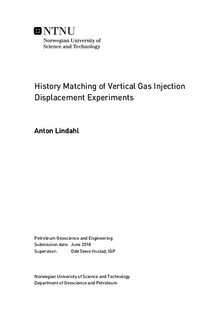| dc.description.abstract | This master thesis presents simulations of two core flooding experiments. The two experiments
consisted of injecting gas in a gravity stablemanner into a vertical core, after
the core had beenwaterflooded. The main difference between the two experiments was
the use of equilibrium gas in the first experiment, while dry separator gas was used in
the second. Using these different injection gases would expose the difference in the oil
production due to mass transfer effects.
The second experiment revealed that as oil was vaporized, water production from
the core increased aswell. Other investigatorswere unsuccessful of simulating this phenomenon
and thus obtaining a proper history match of the water phase. The problem
was identified as a problem with how the capillary pressure was managed throughout
the simulations. Traditional three-phase models does not address the issue.
To properly simulate the two experiments, the ODD3P three-phase model is used.
Thismodel is utilizing saturation functions between all phases, also gas and water. The
model combines hysteresis and miscibility to both capillary pressure and relative permeability
in a continuous manner. Themodel also applies live scaling of capillary pressure
with respect to changing interfacial tension. By using the ODD3P model, it was
possible to obtain a history match of all three phases in both experiments. The increased
water production due to vaporization of oil is accurately simulated by the use
of a transition from water-oil capillary pressure into water-gas capillary pressure. By
applying this transition at very low oil saturation,more water is allowed to flow.
The oil and gas phases are also accurately simulated to history match experimental
data. A surface equation of state is made to perform the flash calculations from reservoir
to standard conditions. Injection of gas created an oil bank in both experiments.
After the oil bank was produced a rather small flow of oil was seen in the first experiment.
In the second experiment oil was produced in fairly high rate after the oil bank
was produced. Analysis of the oil flowmechanisms revealed that thiswas a results of vaporization
of oil. The vaporization effect proved to be significant. Approximately twice
as much oil were recovered by using a dry separator gas instead of an equilibrium gas. | |

